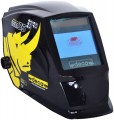Min. degree of darkening
The smallest degree of obscuration provided by the chameleon mask (see "Type") when the light filter is activated. Recall that dimming is indicated in DIN units, the larger the number in this paragraph, the darker the filter.
This parameter is indicated only for models with dimming control (see "Functions"). From the minimum degree of dimming depends on the extent to which you can adjust the light transmission. At the same time, we recall that a darker light filter protects better from bright light, but worsens visibility; so for some tasks, a relatively low level of obscuration may be optimal. Accordingly, the lower this indicator, the wider the adjustment range of the filter, the more opportunities the user has to adjust it (with the same maximum threshold). On the other hand, the expansion of the adjustment range significantly affects the cost, and such characteristics are not always required. Therefore, nowadays, you can find chameleon masks both with a small (
5 DIN and even
less), and with a fairly significant minimum dimming (
7 DIN or even
9 DIN). And it’s worth choosing here, depending on what is more important for you: an extensive range of adjustment or low cost.
Turn-on time
The turn-on time of the filter in the chameleon mask (see "Type"), in other words, the time between striking the arc and darkening the filter to the operating level.
From a safety point of view, the turn-on time should be as short as possible: the faster the "chameleon" works, the less bright light from the arc enters the welder's eyes. On the other hand, reducing the reaction time affects the cost of the product. So for relatively small volumes of work, it is quite acceptable to use relatively “slow” masks — for
100 μs or more(especially since even in the simplest models, the reaction time does not exceed 1200 μs, while theoretically the maximum allowable value is 2000 μs). But for more serious use, you should pay attention to more "fast" options; nowadays, you can find masks with response times
from 75 to 100 µs,
from 50 to 75 µs, and even
less than 50 µs.
Filter viewing area (WxH)
The size of the transparent part of the light filter — the "working window", the area through which the welder sees the place of work. A larger working window provides ease of use and a wide field of view, but it significantly affects the cost of the mask and somewhat reduces the strength of the light filter.
Filter cartridge dimensions (WxH)
The overall dimensions of the light filter for which the mask is designed, taking into account the working window, protrusions for mounting, batteries, sensors and other structural elements. This indicator is especially important for models that are not equipped with light filters: without knowing the size, it is very difficult to choose the right cartridge. In other cases, data on the size of the cartridge is needed mainly when looking for a replacement for a failed colour filter.
Optical sensors
Optical sensors determine the filter response speed. They respond to sudden changes in lighting and arc flicker — characteristic signs of the start of welding work. The more sensors in the mask design, the less likely the filter will open during welding. To better capture the difference in radiation, sensors are often placed at different corners of the mask.
Darkening adjustment
The ability to manually select the degree of darkening of the filter in the chameleon mask. This feature is found mainly in professional models; it allows the welder to manually adjust the light transmission for specific conditions. The need
to adjust the dimming is due to the fact that for some types of work (for example, TIG welding of ferrous metals), the brightness of the arc is relatively low, and in order to see the weld pool normally, dimming of only 8-9 DIN is enough instead of the usual 12 DIN or more .
Grinding mode
A special mode of operation of the chameleon mask, in which the light filter sensors are completely turned off — thus, it constantly remains transparent and does not respond to any flashes. This mode is useful for jobs that can produce fairly bright flashes of light, but do not require dimming. A classic example of such work is grinding with a “grinder” or a machine tool, when sparks can fly from the workpiece; hence the name of this function —
"grinding" mode.
Design features
— Backlight. Illumination system built right into the mask. This feature is very convenient when working in low light conditions: the backlight does not take up the hands (unlike hand-held flashlights) and does not create problems with wearing a mask (unlike headlamps), while the beam of light is always directed to where the welder's head is turned. On the other hand, such a system requires its own power supply. Therefore, it is used only in "chameleons", while the operation of the backlight additionally consumes battery power.

